Insight on Fruit Fly IPM Technology Uptake and Barriers to Scaling in Africa
Abstract
1. Introduction
2. Materials and Methods
2.1. The Questionnaire and Survey
2.2. Data Analysis
3. Results
3.1. Responses and Fruit Fly IPM Initiatives
3.2. Fruit Fly IPM Technological Usage in Africa
3.3. The Level of Fruit Fly IPM Technology Integration and Use in Africa
3.4. Number of Beneficiaries from Fruit Fly IPM in Africa
3.5. Estimation of the Total Number of Tropical Fruit-Growing Populations and Potential Users of Fruit Fly IPM Technologies
3.6. Barriers to the Uptake of IPM Technologies
4. Discussion
5. Conclusions
Author Contributions
Funding
Institutional Review Board Statement
Informed Consent Statement
Data Availability Statement
Acknowledgments
Conflicts of Interest
References
- FAO. The Future of Food and Agriculture–Trends and Challenges; FAO: Rome, Italy, 2017; pp. 1–180. [Google Scholar]
- Weinberger, K.; Lumpkin, T.A. Diversification into horticulture and poverty reduction: A research agenda. World Dev. 2007, 35, 1464–1480. [Google Scholar] [CrossRef]
- Vayssières, J.F.; Sinzogan, A.; Adandonon, A.; Rey, J.Y.; Dieng, E.O.; Camara, K.; Sangarè, M.; Ouedraogo, S.; Sidibé, A.; Keita, Y.; et al. Annual population dynamics of mango fruit flies (Diptera: Tephritidae) in West Africa: Socio-economic aspects, host phenology and implications for management. Fruits 2014, 69, 207–222. [Google Scholar] [CrossRef]
- Badii, K.B.; Billah, M.K.; Afreh–Nuamah, K.; Obeng–Ofori, D.; Nyarko, G. Review of the pest status, economic impact and management of fruit–infesting flies (Diptera: Tephritidae) in Africa. Afr. J. Agric. Res. 2015, 10, 1488–1498. [Google Scholar] [CrossRef]
- White, I.M.; Elson–Harris, M.M. Fruit Flies of Economic Significance: Their Identification and Bionomics; CAB International: Wallingford, UK, 1992. [Google Scholar]
- Rachid, E.; Mazih, A. Current status and future prospects of Ceratitis capitata Wiedemann (Diptera: Tephritidae) control in Morocco. J. Entomol. 2018, 15, 47–55. [Google Scholar] [CrossRef]
- Boulahia–Kheder, S. Review on major fruit flies (Diptera: Tephritidae) in North Africa: Bio–ecological traits and future trends. Crop. Prot. 2021, 140, 105416. [Google Scholar] [CrossRef]
- Vayssières, J.F.; Korie, S.; Coulibaly, O.; Van Melle, C.; Temple, L.; Arinloye, D. The mango tree in central and northern Benin damage caused by fruit flies (Diptera Tephritidae) and computation of economic injury level. Fruits 2009, 64, 207–220. [Google Scholar] [CrossRef]
- Barnes, B.N.; Venter, J.H. The South African fruit fly action plan: Area-wide suppression and exotic species surveillance. In Fruit Flies of Economic Importance: From Basic to Applied Knowledge, Proceedings of the 7th International Symposium on Fruit Flies of Economic Importance, Salvador, Brazil, 10–15 September 2006; IAEA: Vienna, Austria; pp. 271–283.
- José, L.; Cugala, D.; Santos, L. Assessment of invasive fruit fly fruit infestation and damage in Cabo Delgado Province, Northern Mozambique. Afr. Crop. Sci. J. 2013, 21, 21–28. [Google Scholar]
- Nankinga, C.M.; Isabirye, B.E.; Muyinza, H.; Rwomushana, I.; Stevenson, P.C.; Mayamba, A.; Aool, W.; Akol, A.M. Fruit fly infestation in mango: A threat to the Horticultural sector in Uganda. Uganda J. Agric. Sci. 2014, 15, 1–14. [Google Scholar]
- Lux, S.A.; Copeland, R.S.; White, I.M.; Manrakhan, A.; Billah, M.K. A new invasive fruit fly species from the Bactrocera dorsalis (Hendel) group detected in East Africa. Int. J. Trop. Insect. Sci. 2003, 23, 355–361. [Google Scholar] [CrossRef]
- Ekesi, S.; Lux, S.A.; Billah, M.K. Field comparison of food–based synthetic attractants and traps for African Tephritid fruit flies. In Development of Improved Attractants and Their Integration into Fruit Fly SIT Management Programmes; IAEA: Vienna, Austria, 2007; pp. 205–222. [Google Scholar]
- Ekesi, S.; Nderitu, P.W.; Rwomushana, I. Field infestation, life history and demographic parameters of the fruit fly Bactrocera invadens (Diptera: Tephritidae) in Africa. Bull. Entomol. Res. 2006, 96, 379–386. [Google Scholar]
- De Meyer, M.; Mohamed, S.A.; Virgilio, M.; Borgemeister, C. Taxonomy, ecology, and management of native and exotic fruit fly species in Africa. Ann. Rev. Entomol. 2016, 61, 219–238. [Google Scholar]
- De Meyer, M.; Robertson, M.P.; Peterson, A.T.; Mansell, M.W. Ecological niches and potential geographical distributions of Mediterranean fruit fly (Ceratitis capitata) and Natal fruit fly (Ceratitis rosa). J. Biogeog. 2008, 35, 270–281. [Google Scholar] [CrossRef]
- Drew, R.A.I.; Tsuruta, K.; White, I.M. A new species of pest fruit fly (Diptera: Tephritidae: Dacinae) from Sri Lanka and Africa. Afr. Entomol. 2005, 13, 149–154. [Google Scholar]
- Mwatawala, M.W.; De Meyer, M.; Makundi, R.H.; Maerere, A.P. An overview of Bactrocera (Diptera: Tephritidae) invasions and their speculated dominancy over native fruit fly species in Tanzania. J. Econ. Entomo. 2009, 6, 18–27. [Google Scholar] [CrossRef]
- Ekesi, S.; Mohamed, S.A.; De Meyer, M. Fruit Fly Research and Development in Africa–Towards a Sustainable Strategy to Improve Horticulture; Springer International Publishing: Cham, Switzerland, 2016; p. 778. [Google Scholar]
- Rwomushana, I.; Ekesi, S.; Gordon, I.; Ogol, C.K. Host plants and host plant preference studies for Bactrocera invadens (Diptera: Tephritidae) in Kenya, a new invasive fruit fly species in Africa. Ann. Entomol. Soc. Am. 2008, 101, 331–340. [Google Scholar] [CrossRef]
- Lysandrou, M. Fruit flies in the Mediterranean and Arab world: How serious a threat are they and how can we minimize their impact. Arab. J. Plant. Prot. 2009, 27, 236–239. [Google Scholar]
- Kheder, S.B.; Trabelsi, I.; Aouadi, N. From chemicals to IPM against the Mediterranean fruit fly Ceratitis capitata (Diptera, Tephritidae). In Integrated Pest Management and Pest Control–Current and Future Tactics; Larramendy, M.L., Soloneski, S., Eds.; InTech: Rijeka, Croatia, 2012; pp. 301–320. [Google Scholar]
- Boulahia–Kheder, S.; Chaabane–Boujnah, H.; Bouratbine, M.; Rezgui, S. IPM based on mass trapping systems: A control solution for Ceratitis capitata (Wiedemann, 1824) (Diptera: Tephritidae) in organic citrus orchard of Tunisia. Res. J. Agric. Environ. Manag. 2015, 4, 459–469. [Google Scholar]
- Couso–Ferrer, F.; Arouri, R.; Beroiz, B.; Perera, N.; Cervera, A.; Navarro–Llopis, V.; Ortego, F. Cross–resistance to insecticides in a malathion–resistant strain of Ceratitis capitata (Diptera: Tephritidae). J. Econ. Entomol. 2011, 104, 1349–1356. [Google Scholar] [CrossRef]
- Gill, H.K.; Garg, H. Pesticide: Environmental impacts and management strategies. In Pesticides–Toxic Effects; Solenski, S., Larramenday, M.L., Eds.; Intech: Rejeka, Croatia, 2014; pp. 187–230. [Google Scholar]
- Mebdoua, S. Pesticide residues in fruits and vegetables. In Bioactive Molecules in Food. Reference Series in Phytochemistry; Mérillon, J.M., Ramawat, K., Eds.; Springer: Cham, Switzerland, 2018; pp. 1715–1753. [Google Scholar]
- Muriithi, B.W.; Affognon, H.D.; Diiro, G.M.; Kingori, S.W.; Tanga, C.M.; Nderitu, P.W.; Mohamed, S.A.; Ekesi, S. Impact assessment of Integrated Pest Management (IPM) strategy for suppression of mango–infesting fruit flies in Kenya. Crop. Prot. 2016, 81, 20–29. [Google Scholar] [CrossRef]
- Korir, J.K.; Affognon, H.D.; Ritho, C.N.; Kingori, W.S.; Irungu, P.; Mohamed, S.A.; Ekesi, S. Grower adoption of an integrated pest management package for management of mango-infesting fruit flies (Diptera: Tephritidae) in Embu, Kenya. Int. J. Trop. Insect. Sci. 2015, 35, 80–89. [Google Scholar] [CrossRef]
- Grout, T.G. Cold and heat treatment technologies for post–harvest control of fruit flies in Africa. In Fruit Fly Research and Development in Africa—Towards a Sustainable Strategy to Improve Horticulture; Ekesi, S., Mohamed, S.A., De Meyer, M., Eds.; Springer International Publishing: Cham, Switzerland, 2016; pp. 465–473. [Google Scholar]
- Kibira, M.; Affognon, H.; Njehia, B.; Muriithi, B.; Ekesi, S. Economic Evaluation of Integrated Management of Fruit Fly in Mango Production in Embu County, Kenya. Afr. J. Agric. Resour. Manag. 2015, 10, 343–353. [Google Scholar]
- Midingoyi, S.K.G.; Kassie, M.; Muriithi, B.; Diiro, G.; Ekesi, S. Do farmers and the environment benefit from adopting integrated pest management practices? Evidence from Kenya. J. Agric. Econ. 2019, 70, 452–470. [Google Scholar] [CrossRef]
- Muriithi, B.W.; Gathogo, N.; Rwomushana, I.; Diiro, G.; Mohamed Faris, S.; Khamis, F.; Tanga, C.; Ekesi, S. Farmers’ knowledge and perceptions on fruit flies and willingness to pay for a fruit fly integrated pest management strategy in Gamo Gofa zone, Ethiopia. Int. J. Agric. Sustain. 2021, 19, 199–212. [Google Scholar] [CrossRef]
- Wangithi, C.M.; Muriithi, B.W.; Belmin, R. Adoption and Dis–Adoption of Sustainable Agriculture: A case of farmers’ innovations and integrated fruit fly management in Kenya. Agriculture 2021, 11, 338. [Google Scholar] [CrossRef]
- Okello, J. Tracking Indirect Beneficiaries of Complex Development Interventions in Agriculture; Technical Report for International Potato Centre (CIP): Lima, Peru, 2019; p. 19. [Google Scholar]
- Hijmans, R.J.; van Etten, J. Geographic analysis and modeling with raster data. In R Package Version 2.0–12; CRAN: Windhoek, Namibia, 2012; Available online: http://CRAN.R–project.org/package=raster (accessed on 17 November 2021).
- Food and Agriculture Organization of the United Nations. 2019. Production: Crops. Available online: http://faostat.fao.org (accessed on 17 November 2021).
- R Core Team. R: A Language and Environment for Statistical Computing; R Foundation for Statistical Computing: Vienna, Austria, 2020; Available online: https://www.R–project.org/ (accessed on 17 November 2021).
- Ndlela, S.; Mwando, N.L.; Samira, A.; Mohamed, S.A. Advances in postharvest disinfestation of fruits and vegetables using hot water treatment technology–updates from Africa. In Postharvest Technology–Recent Advances, New Perspectives and Applications; IntechOpen: London, UK, 2021. [Google Scholar]
- Muriithi, B.W.; Gathogo, N.G.; Diiro, G.M.; Mohamed, S.A.; Ekesi, S. Potential Adoption of Integrated Pest Management Strategy for Suppression of Mango Fruit Flies in East Africa: An Ex–Ante and Ex Post Analysis in Ethiopia and Kenya. Agriculture 2020, 10, 278. [Google Scholar] [CrossRef]
- Boulahia–Kheder, S.; Loussaïef, F.; Ben Hmidène, A.; Trabelsi, I.; Jrad, F.; Akkari, Y.; Fezzani, M. Evaluation of two IPM programs based on mass–trapping against the Mediterranean fruit fly Ceratitis capitata on citrus orchards. Tunis. J. Plant Prot. 2012, 7, 55–68. [Google Scholar]
- International Assessment of Agricultural Knowledge, Science and Technology for Development (IAASTD). Agriculture at a Crossroads: Global Report. Available online: https://wedocs.unep.org/handle/20.500.11822/8590 (accessed on 20 November 2021).
- Glover, D.; Venot, J.P.; Maat, H. On the movement of agricultural technologies packaging, unpacking and situated reconfiguration. In Agronomy for Development: The Politics of Knowledge in Agricultural Research; Sumberg, J., Ed.; Abingdon: Routledge, UK, 2017; pp. 14–30. [Google Scholar]
- Ajayi, M.T.; Fatunbi, A.O.; Akinbamijo, O.O. Strategies for Scaling Agricultural Technologies in Africa; Forum for Agricultural Research in Africa (FARA): Accra, Ghana, 2018; pp. 1–180. [Google Scholar]
- Boulahia–Kheder, S.; Turki, S.; Gouay, M.; Limem, E. Assessment of IPM against the Mediterranean fruit fly implemented at regional scale in Tunisia. IOBC WPRS Bull. 2018, 132, 177–184. [Google Scholar]
- Liquido, N.J. Fruits on the ground as reservoir of resident melon fly (Diptera: Tephritidae) populations in papaya orchards. Environ. Entomol. 1991, 20, 620–625. [Google Scholar] [CrossRef]
- Allwood, A.J. Control strategies for fruit flies (Family Tephritidae) in the South Pacific. In Management of Fruit Flies in the Pacific. A Regional Symposium, Nadi, Fiji, Australia, 28–31 October 1996; Australian Centre for International Agricultural Research: Canberra, Australia, 1997; pp. 171–178. [Google Scholar]
- Jang, E.B.; Klungness, L.M.; McQuate, G.T. Extension of the use of Augmentoria for sanitation in a cropping system susceptible to the alien Tephritid fruit flies (Diptera: Terphritidae) in Hawaii. J. Appl. Sci. Environ. Manag. 2007, 11, 239–248. [Google Scholar]
- Klungness, L.M.; Jang, E.B.; Mau, R.F.L.; Vargas, R.I.; Sugano, J.S.; Fujitani, E. Sanitation techniques for controlling Tephritid fruit flies (Diptera: Tephritidae) in Hawaii. J. Appl. Sci. Environ. Manag. 2005, 9, 5–14. [Google Scholar] [CrossRef][Green Version]
- Ekesi, S.; Billah, M.K. A Field Guide to the Management of Economically Important Tephritid Fruit Flies in Africa, 2nd ed.; ICIPE Science Press: Nairobi, Kenya, 2007; pp. 1–577. [Google Scholar]
- Allwood, A.J.; Drew, R.A.I. Management of fruit flies in the Pacific. In Management of Fruit Flies in the Pacific. A Regional Symposium, Nadi, Fiji, Australia, 28–31 October 1996; Australian Centre for International Agricultural Research: Canberra, Australia, 1997. [Google Scholar]
- Steiner, L.F.; Rohwer, G.G.; Ayers, E.L.; Christenson, L.D. The role of attractants in the recent Mediterranean fruit fly eradication program in Florida. J. Econ. Entomol. 1961, 54, 30–35. [Google Scholar] [CrossRef]
- Ekesi, S.; Tanga, C.T. Waste brewer’s yeast as an alternative source of protein for use as a bait in the management of tephritid fruit flies. In Fruit Fly Research and Development in Africa—Towards a Sustainable Strategy to Improve Horticulture; Ekesi, S., Mohamed, S.A., De Meyer, M., Eds.; Springer International Publishing: Cham, Switzerland, 2016; pp. 293–306. [Google Scholar]
- Bagheri, A.; Kolyaee, R.; Seyahooei, M.; Najafabadi, S.S.M.; Faraji, G. Efficacy of methyl eugenol bait traps for controlling the mango fruit fly Bactrocera zonata (Diptera: Tephritidae). J. Crop. Prot. 2017, 6, 181–189. [Google Scholar]
- Cunningham, R.T. Male annihilation. In Fruit Flies—Their Biology, Natural Enemies and Control; Robinson, A.S., Hooper, G., Eds.; Elsevier: Amsterdam, The Netherlands, 1989; Volume 3B, pp. 345–351. [Google Scholar]
- Maniania, J.N.K.; Ekesi, S. Development and application of mycoinsecticides for the management of fruit flies in Africa. In Fruit Fly Research and Development in Africa—Towards a Sustainable Strategy to Improve Horticulture; Ekesi, S., Mohamed, S.A., De Meyer, M., Eds.; Springer International Publishing: Cham, Switzerland, 2016; pp. 307–324. [Google Scholar]
- Shilomboleni, H.; De Plaen, R. Scaling up research–for–development innovations in food and agricultural systems. Dev. Pract. 2019, 29, 723–734. [Google Scholar] [CrossRef]
- East African Community (EAC) harmonized guidelines for the Registration of Biopesticides and Bio Control Agents for plant protection. Available online: http://repository.eac.int/handle/11671/24128 (accessed on 28 November 2019).
- Mohamed, S.A.; Ramadan, M.M.; Ekesi, S. In and out of Africa: Parasitoids used for biological control of fruit flies. In Fruit Fly Research and Development in Africa—Towards a Sustainable Strategy to Improve Horticulture; Ekesi, S., Mohamed, S.A., De Meyer, M., Eds.; Springer International Publishing: Cham, Switzerland, 2016; pp. 325–368. [Google Scholar]
- Mohamed, S.A.; Wharton, R.A.; von Mérey, G.; Schulthess, F. Acceptance and suitability of different host stages of Ceratitis capitata (Wiedemann) (Diptera: Tephritidae) and seven other tephritid fruit fly species to Tetrastichus giffardii Silvestri (Hymenoptera: Eulophidae). Biol. Control 2006, 39, 262–271. [Google Scholar] [CrossRef]
- Wharton, R. Classification of the braconid subfamily Opiinae (Hymenoptera). Can. Entomol. 1988, 120, 333–360. [Google Scholar] [CrossRef]
- Wharton, R.A. A review of the Old–World genus Fopius Wharton (Hymenoptera: Braconidae: Opiinae), with description of two new species reared from fruit–infesting Tephritidae (Diptera). J. Hymenopt. Res. 1999, 8, 48–64. [Google Scholar]
- Vargas, R.I.; Leblanc, L.; Putoa, R.; Eitam, A. Impact of introduction of Bactrocera dorsalis (Diptera: Tephritidae) and classical biological control releases of Fopius arisanus (Hymenoptera: Braconidae) on economically important fruit flies in French Polynesia. J. Econ. Entomol. 2007, 100, 670–679. [Google Scholar] [CrossRef]
- Vargas, R.I.; Leblanc, L.; McKenney, M.; Mackey, B.; Harris, E.J.; Badji, K. Rearing Fopius arisanus (Sonan) (Hymenoptera: Braconidae) on Mediterranean fruit fly and its introduction into Senegal against Oriental fruit fly (Diptera: Tephritidae). Proc. Hawaii. Entomol. Soc. 2016, 48, 85–94. [Google Scholar]
- Mohamed, S.A.; Ekesi, S.; Hanna, R. Evaluation of the impact of Diachasmimorpha longicaudata on Bactrocera invadens and five African fruit fly species. J. Appl. Entomol. 2008, 132, 789–797. [Google Scholar] [CrossRef]
- Mohamed, S.A.; Ekesi, S.; Hanna, R. Old and new host–parasitoid associations: Parasitism of the invasive fruit fly Bactrocera invadens (Diptera: Tephritidae) and five African fruit fly species by Fopius arisanus, an Asian opiine parasitoid. Biocontrol. Sci. Technol. 2010, 20, 183–196. [Google Scholar] [CrossRef]
- Ekesi, S.; Billah, M.K.; Nderitu, P.W.; Lux, S.A.; Rwomushana IV, I. Evidence for competitive displacement of Ceratitis cosyra by the invasive fruit fly Bactrocera invadens (Diptera: Tephritidae) on mango and mechanisms contributing to the displacement. J. Econc. Entomol. 2009, 102, 981–991. [Google Scholar] [CrossRef] [PubMed]
- Ekesi, S. What can farmers do against fruit flies? Org. Farmer 2010, 59, 2–6. [Google Scholar]
- Gnanvossou, D.; Hanna, R.; Bokonon–Ganta, A.H.; Ekesi, S.; Mohamed, S.A. Release, establishment and spread of the natural enemy Fopius arisanus (Hymenoptera: Braconidae) for control of the invasive oriental fruit fly Bactrocera dorsalis (Diptera: Tephritidae) in Benin, West Africa. In Fruit Fly Research and Development in Africa—Towards a Sustainable Strategy to Improve Horticulture; Ekesi, S., Mohamed, S.A., De Meyer, M., Eds.; Springer International Publishing: Cham, Switzerland, 2016; pp. 575–600. [Google Scholar]
- Barnes, B.N. Sterile Insect Technique (SIT) for Fruit Fly Control—The South African Experience. In Fruit Fly Research and Development in Africa—Towards a Sustainable Management Strategy to Improve Horticulture; Ekesi, S., Mohamed, S., De Meyer, M., Eds.; Springer International Publishing: Cham, Switzerland, 2016; pp. 435–464. [Google Scholar]
- Venter, J.–H.; Baard, C.; Barnes, B.N. Area–Wide Management of Mediterranean Fruit Fly with the Sterile Insect Technique in South Africa: New Production and Management Techniques Pay Dividends; CRC Press: Boca Raton, FL, USA, 2020; pp. 129–141. [Google Scholar]
- Klaussen, W. Area wide integrated pest management and the sterile insect technique. In Sterile Insect Technique Principles and Practices in Area Wide Pest Management; Dyck, V.A., Hendrichs, J., Robbinson, A.S., Eds.; Springer International Publishing: Cham, Switzerland, 2005; pp. 36–39. [Google Scholar]
- Isabirye, B.; Nankinga, C.K.; Mayamba, A.; Akol, A.M.; Rwomushana, I. Integrated management of fruit flies—Case studies from Uganda. In Fruit Fly Research and Development in Africa—Towards a Sustainable Strategy to Improve Horticulture; Ekesi, S., Mohamed, S.A., De Meyer, M., Eds.; Springer International Publishing: Cham, Switzerland, 2016; pp. 497–515. [Google Scholar]
- Umeh, V.; Onukwu, D. Integrated management of fruit flies: Case studies from Nigeria. In Fruit Fly Research and Development in Africa—Towards a Sustainable Strategy to Improve Horticulture; Ekesi, S., Mohamed, S.A., De Meyer, M., Eds.; Springer International Publishing: Cham, Switzerland, 2016; pp. 553–574. [Google Scholar]
- Adamo, A. Participatory Agricultural Research Processes in Eastern and Central Ethiopia: Using Farmers’ Social Networks as Entry Points for PR Activities. Network on Bean Research in Africa; Occasional Publications Series: Kampala, Uganda, 2001. [Google Scholar]
- German, L.; Mowo, J.; Kingamkono, M. A methodology for tracking the “fate” of technological interventions in agriculture. Agric. Hum. Values 2006, 23, 353–369. [Google Scholar] [CrossRef]
- Jemaa, J.M.B.; Bachrouch, O.; Allimi, E.; Dhouibi, M.H. Field evaluation of Mediterranean fruit fly mass trapping with Tripack® as alternative to malathion bait–spraying in citrus orchards. Span. J. Agric. Res. 2010, 8, 400–408. [Google Scholar] [CrossRef]
- Asfers, A.; Joutei, A.B.; Boughdad, A.; Blenzar, A.; Lahlali, R.; Houssa, A.A. Comparative efficacy of mass trapping and attract–and–kill technique in the control of medfly (Ceratitis capitata, Wiedemann) in Central Moroccan peach orchard. Pestic. Phytomed. 2018, 33, 53–63. [Google Scholar] [CrossRef]
- Van Mele, P.; Vayssières, J.–F.; Van Tellingen, E.; Vrolijks, J. Effects of an African weaver ant, Oecophylla longinoda, in controlling mango fruit flies (Diptera Tephritidae) in Benin. J. Econ. Entomol. 2007, 100, 695–701. [Google Scholar]
- Vayssières, J.–F.; Offenberg, J.; Sinzogan, A.; Adandonon, A.; Wargui, R.; Anato, F.; Houngbo, H.Y.; Ouagoussounon, I.; Diamé, L.; Quilici, S.; et al. The use of weaver ants in the management of fruit flies in Africa. In Fruit Fly Research and Development in Africa—Towards a Sustainable Strategy to Improve Horticulture; Ekesi, S., Mohamed, S., De Meyer, M., Eds.; Springer International Publishing: Cham, Switzerland, 2016; pp. 389–434. [Google Scholar]
- Cowen, R. Tortoises and hares: Choice among technologies of unknown merit. Econ. J. 1991, 101, 801–814. [Google Scholar] [CrossRef]
- Cowen, R.; Gunby, P. Sprayed to death: Path dependence, lock–in and pest–control strategies. Econ. J. 1996, 106, 521–542. [Google Scholar] [CrossRef]
- Deguine, J.–P.; Aubertot, J.–N.; Flor, R.J.; Lescourret, F.; Wyckhuys, K.A.G.; Ratnadass, A. Integrated pest management: Good intentions, hard realities. A review. Agron. Sustain. Dev. 2021, 41, 38. [Google Scholar] [CrossRef]
- Alwang, J.; Norton, G.; Larochelle, C. Obstacles to widespread diffusion of IPM in developing countries: Lessons from the field. J. Integ. Pest. Manag. 2019, 10, 10. [Google Scholar] [CrossRef]
- Morse, S.; Buhler, W. IPM in developing countries: The danger of an ideal. Integr. Pest Manag. Rev. 1997, 2, 175–185. [Google Scholar] [CrossRef]
- Rebaudo, F.; Carpio, C.; Crespo–Pérez, V.; Herrera, M.; de Scurrah, M.M.; Canto, R.C.; Montañez, A.G.; Bonifacio, A.; Mamani, M.; Saravia, R.; et al. Agent–based models and integrated pest management diffusion in small scale farmer communities. In Integrated Pest Management; Springer: Dordrecht, The Netherlands, 2014; pp. 367–383. [Google Scholar]
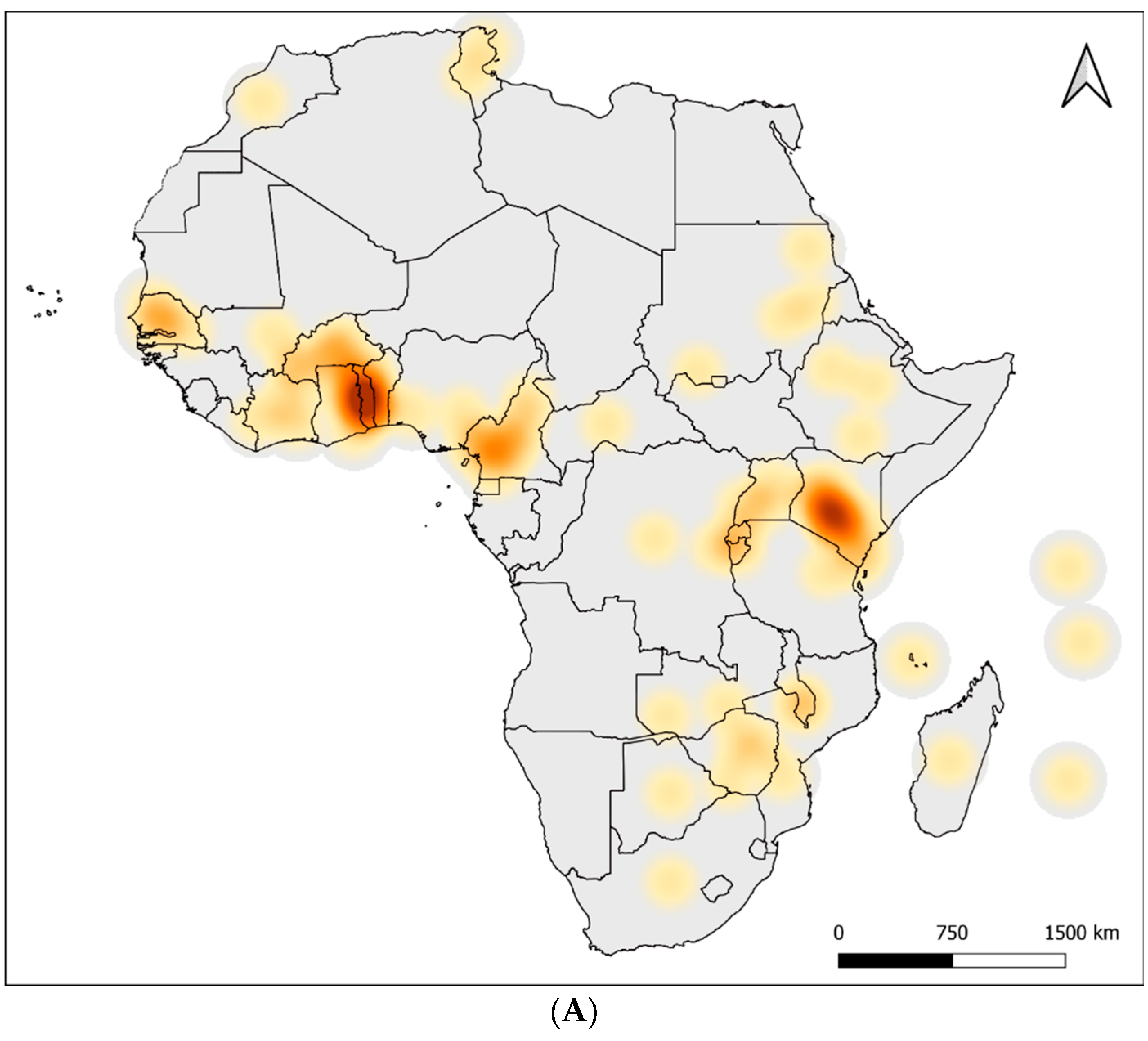
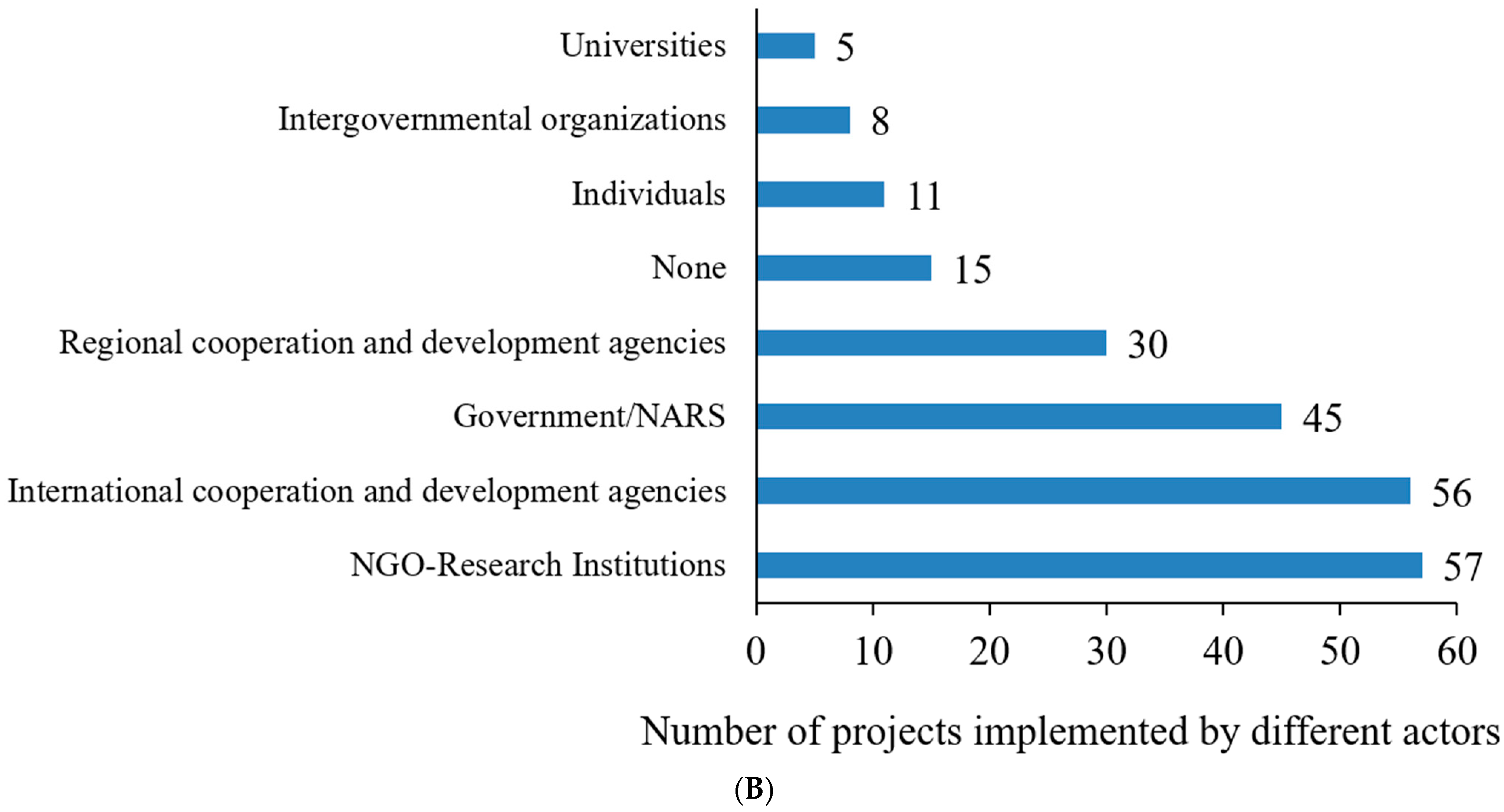
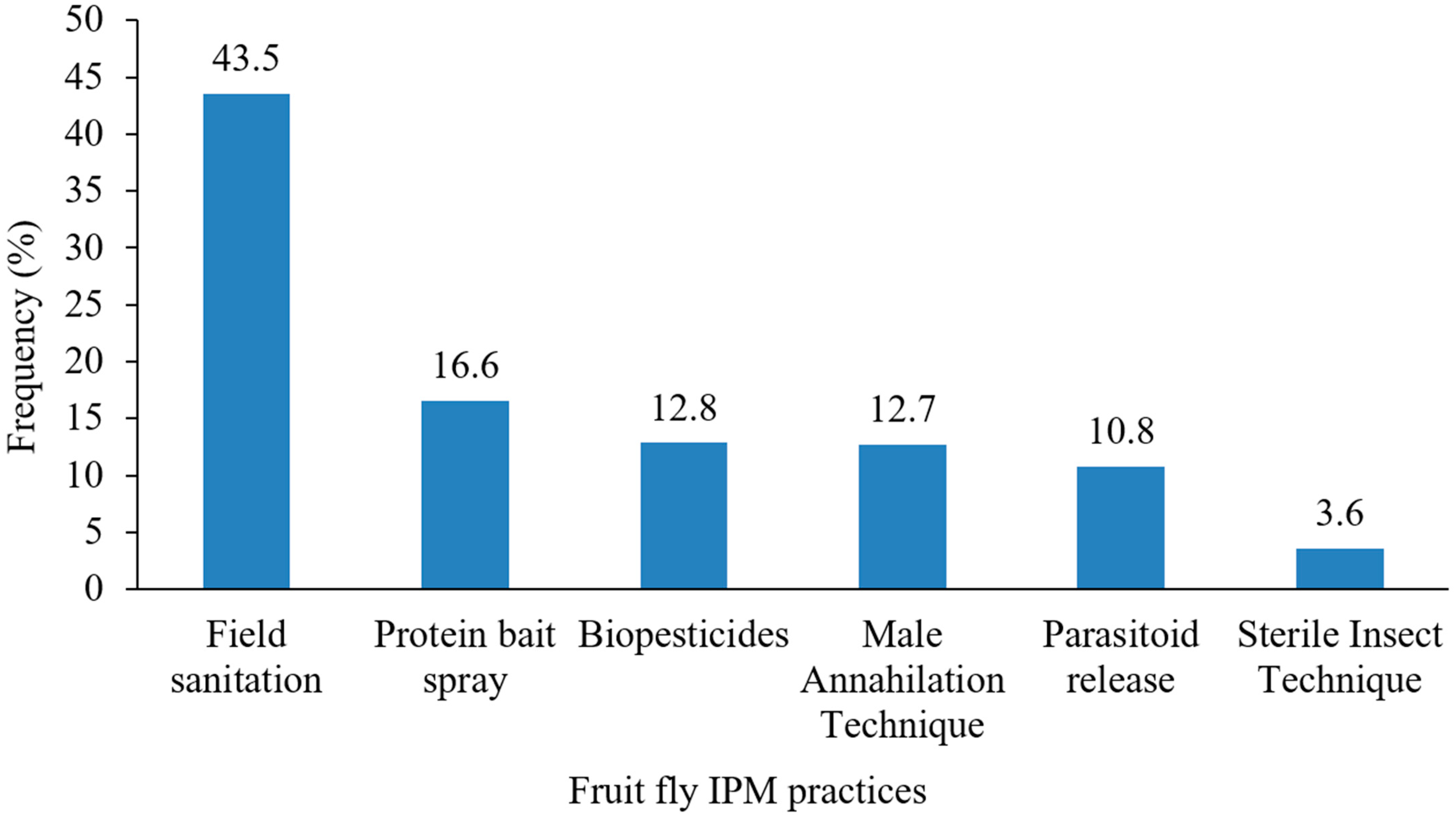
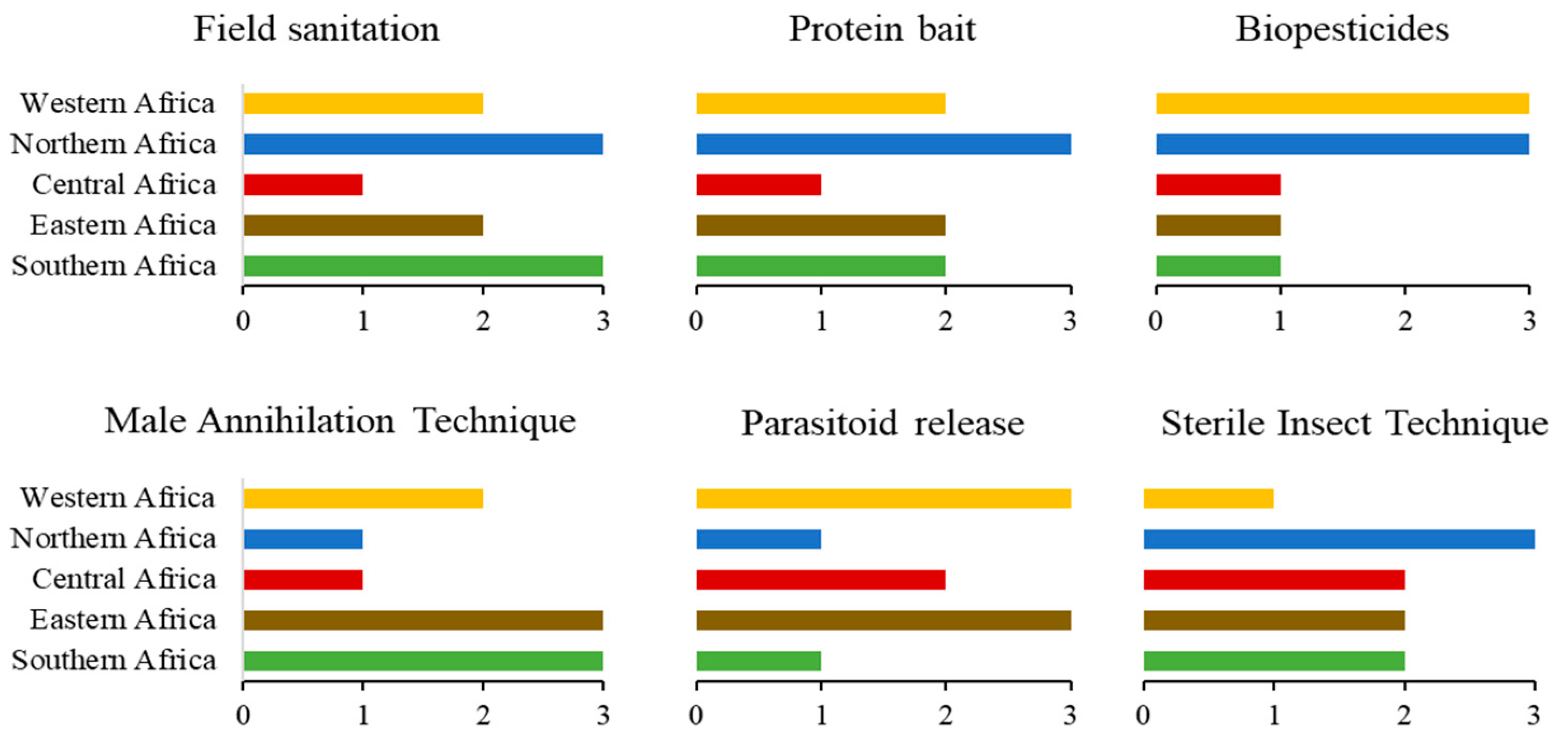
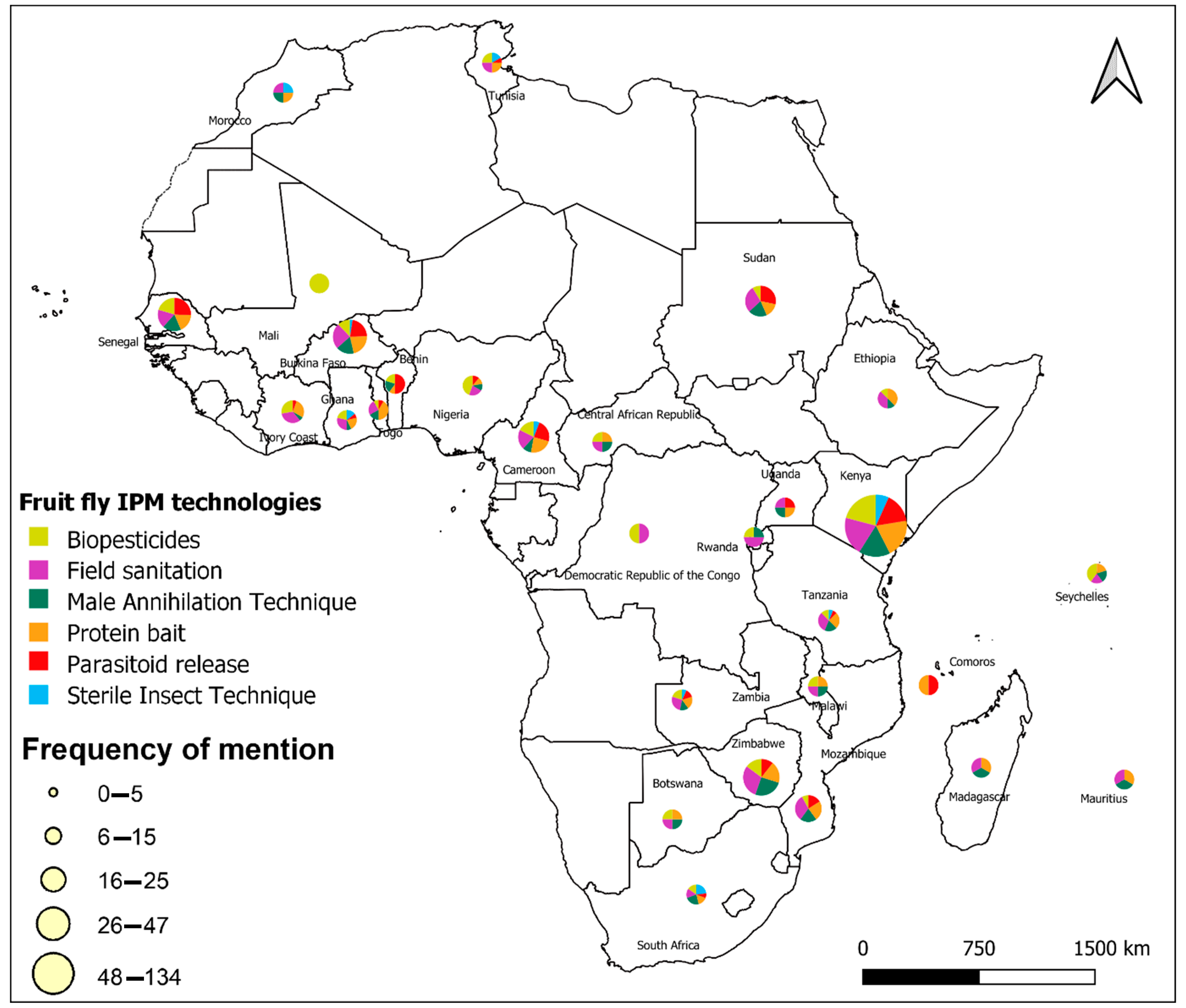
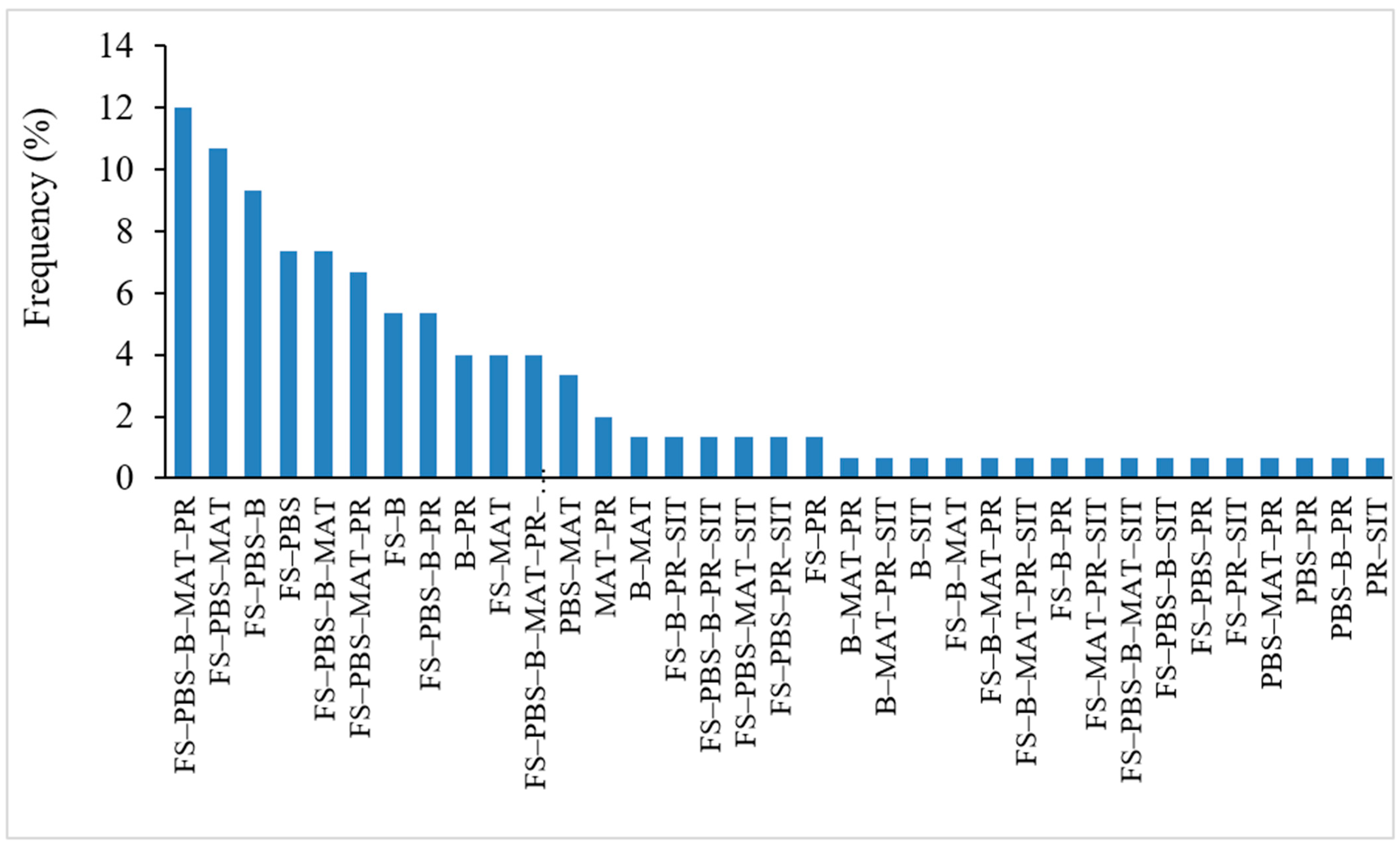
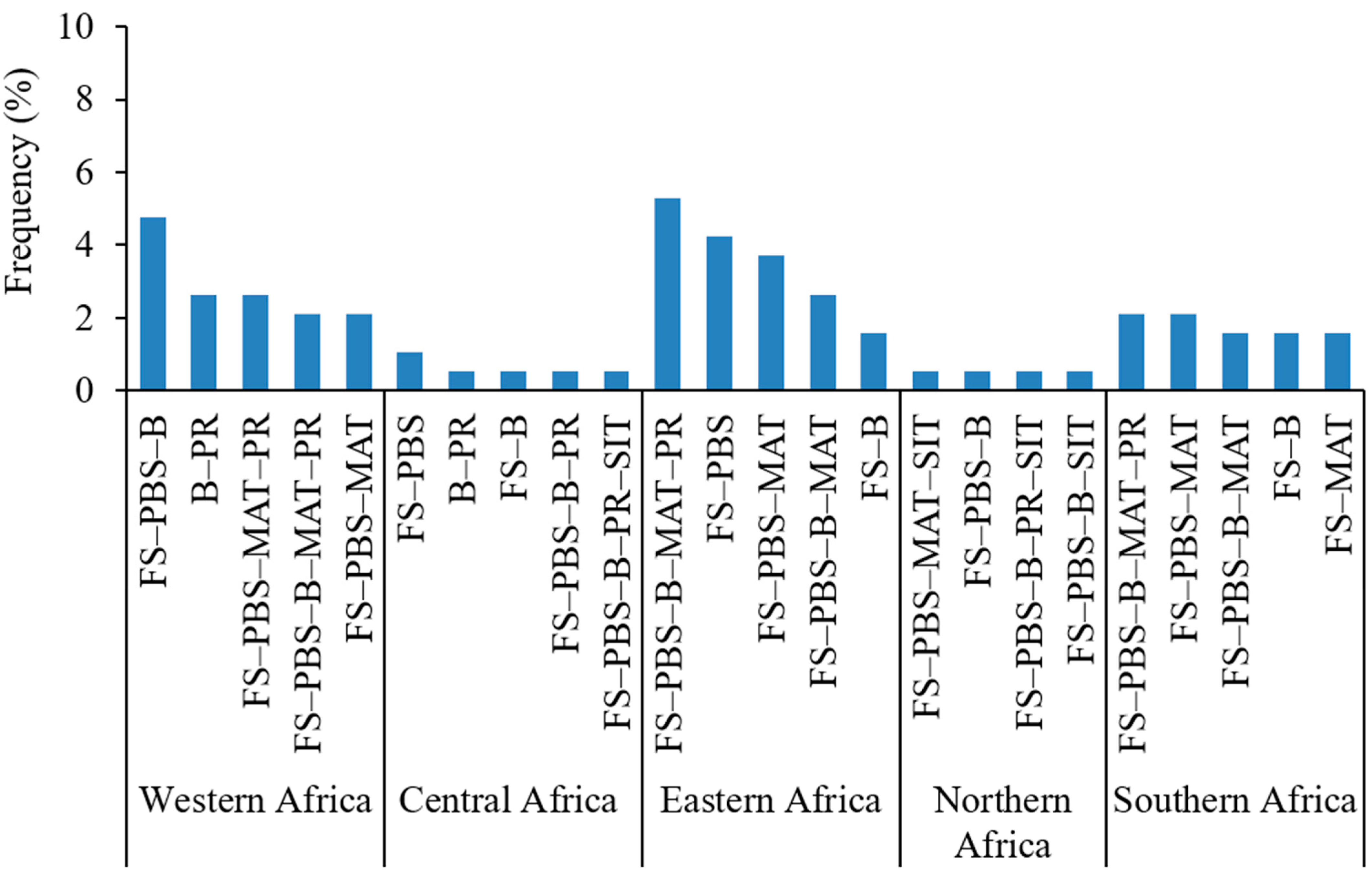
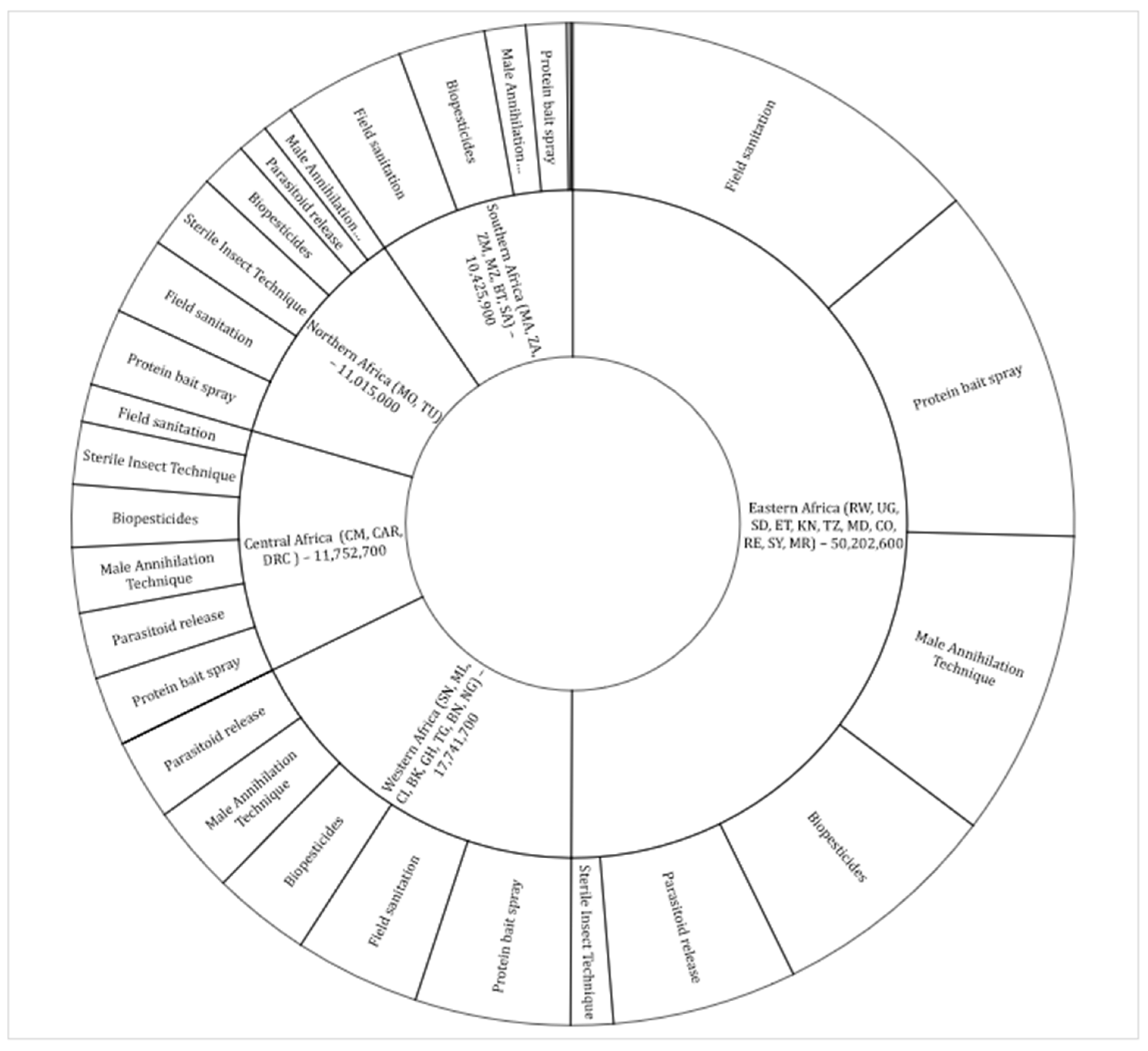
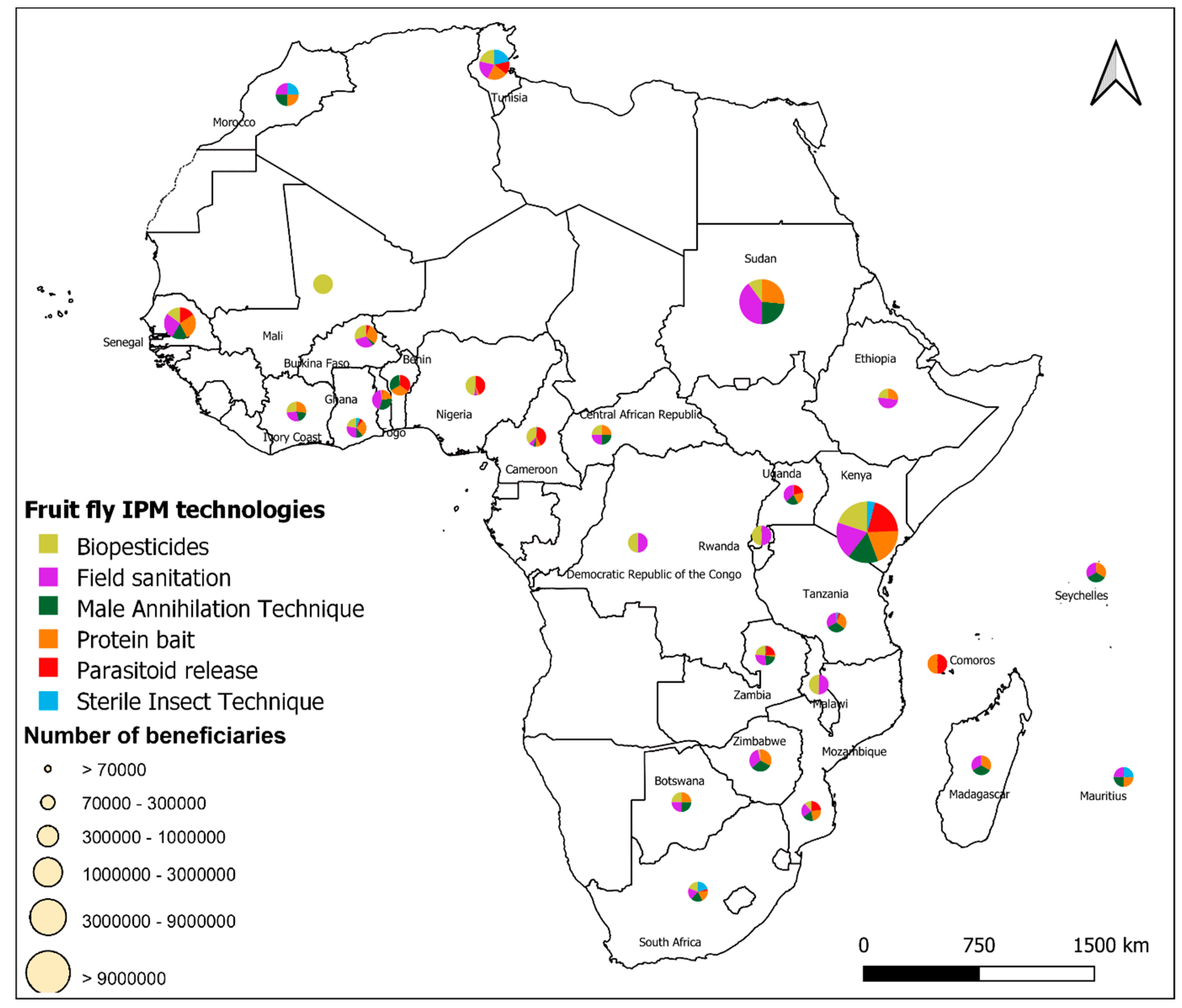
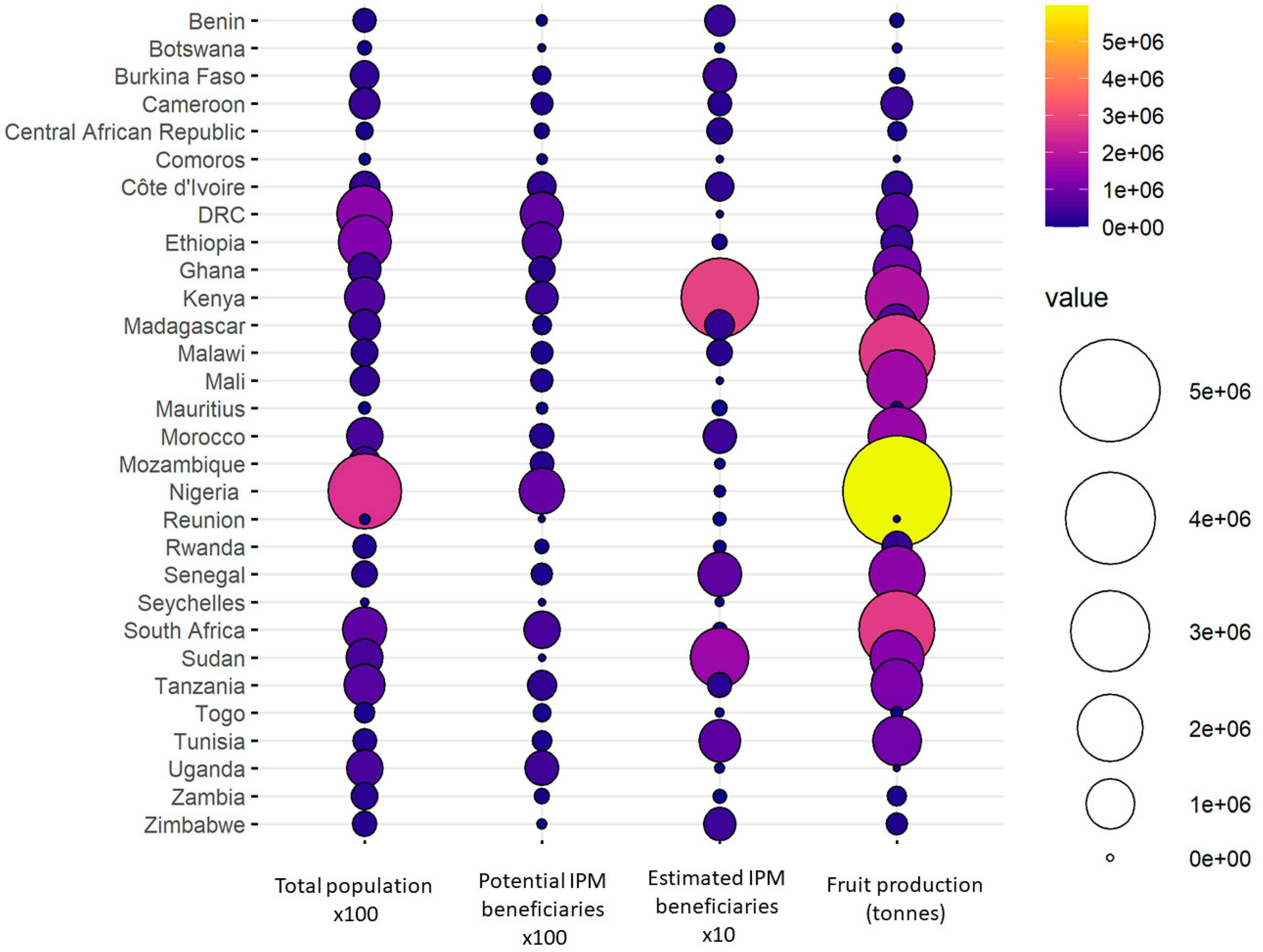
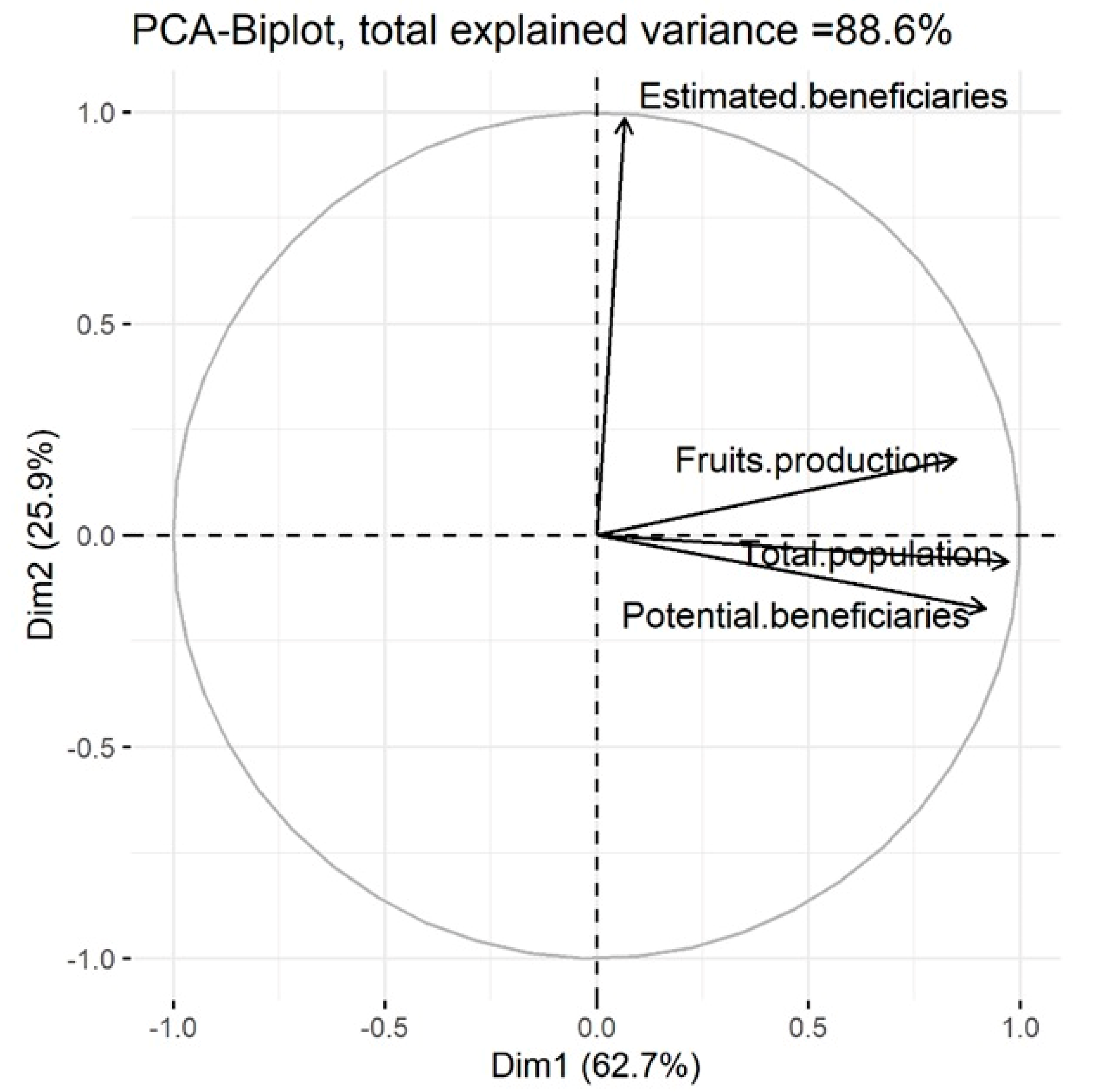
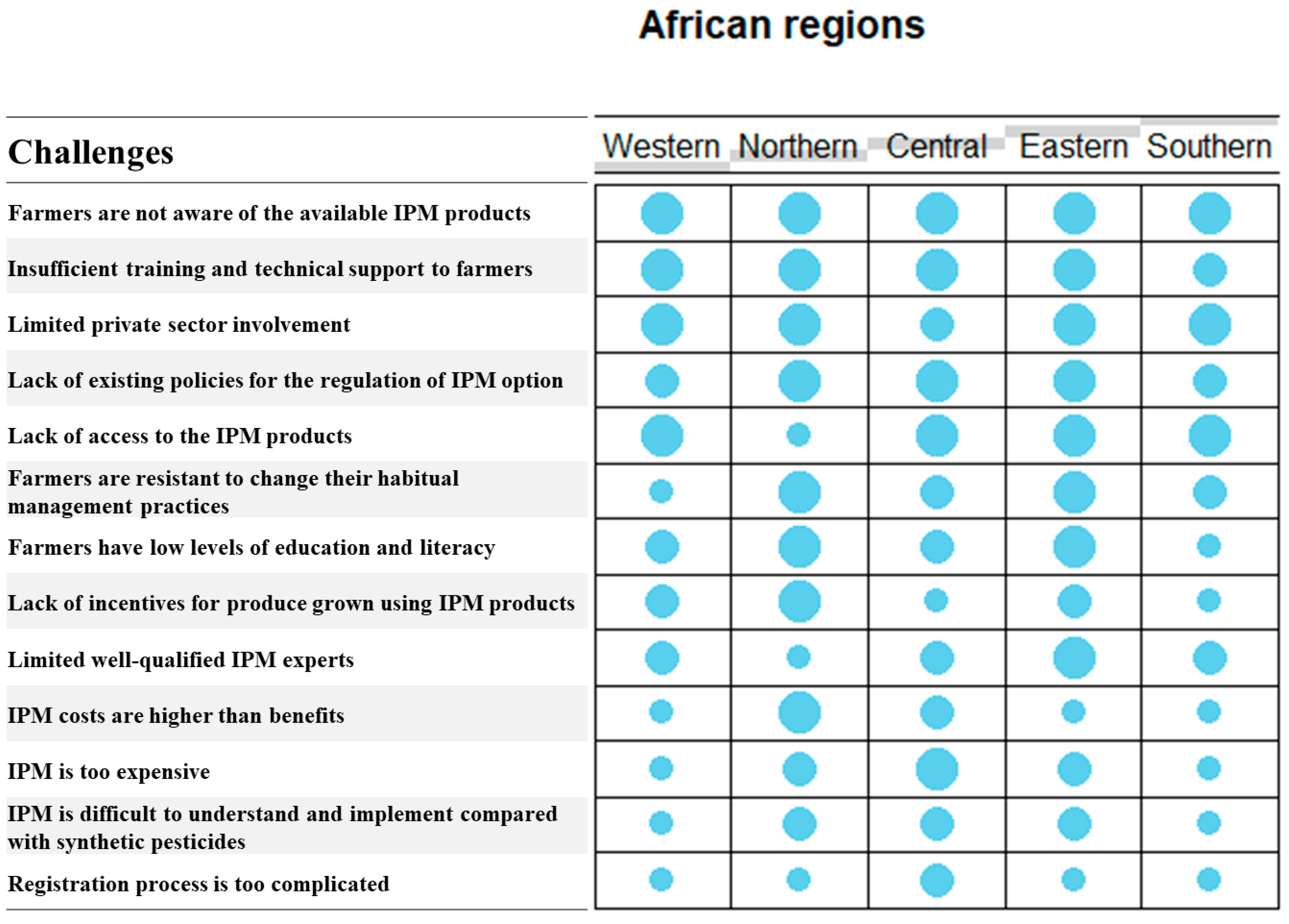
| Countries | IPM Technologies | |||||||||||||||||
|---|---|---|---|---|---|---|---|---|---|---|---|---|---|---|---|---|---|---|
| Field Sanitation | a MAT | Biopesticides | Protein Bait Spray | Parasitoid Releases | b SIT | |||||||||||||
| Estimate | Z Score | Estimate | Z Score | Estimate | Z Score | Estimate | Z Score | Estimate | Z Score | Estimate | Z Score | |||||||
| Benin | −19.222 | −0.006 | ns | −0.146 | −0.140 | ns | −1.755 | −1.462 | ns | −1.649 | −1.375 | ns | 17.517 | 0.009 | ns | −18.434 | −0.003 | ns |
| Burkina Faso | 0.847 | 0.999 | ns | 0.413 | 0.589 | ns | −1.216 | −1.718 | ns | 0.431 | 0.574 | ns | 0.932 | 1.250 | ns | −1.171 | −1.055 | ns |
| Cameroon | −1.262 | −2.087 | * | −1.325 | −2.033 | * | −1.013 | −1.710 | ns | −0.432 | −0.740 | ns | −0.166 | −0.288 | ns | −0.883 | −1.057 | ns |
| Côte d’Ivoire | 17.909 | 0.007 | ns | −1.756 | −1.541 | ns | 0.952 | 0.833 | ns | 1.059 | 0.927 | ns | −1.658 | −1.456 | ns | −18.434 | −0.004 | ns |
| Ethiopia | −0.251 | −0.259 | ns | −1.532 | −1.320 | ns | −2.043 | −1.753 | ns | −0.144 | −0.149 | ns | −17.614 | −0.010 | ns | −18.434 | −0.004 | ns |
| Ghana | 17.909 | 0.005 | ns | −0.839 | −0.664 | ns | 0.036 | 0.029 | ns | 16.020 | 0.012 | ns | −0.741 | −0.587 | ns | 0.438 | 0.343 | ns |
| Mozambique | 17.909 | 0.008 | ns | 0.364 | 0.458 | ns | −1.755 | −1.994 | * | 0.548 | 0.624 | ns | −0.048 | −0.063 | ns | −18.434 | −0.005 | ns |
| Nigeria | 0.036 | 0.029 | ns | −16.712 | −0.012 | ns | 16.909 | 0.007 | ns | −1.243 | −0.981 | ns | −0.741 | −0.587 | ns | −18.434 | −0.003 | ns |
| Senegal | −0.097 | −0.137 | ns | 0.413 | 0.589 | ns | 0.324 | 0.430 | ns | 0.010 | 0.014 | ns | 2.253 | 2.059 | * | −18.434 | −0.006 | ns |
| South Africa | 0.036 | 0.029 | ns | 0.5465 | 0.432 | ns | 0.036 | 0.029 | ns | 0.43 | 0.113 | ns | −0.741 | −0.587 | ns | 20.697 | 0.003 | ns |
| Sudan | 1.828 | 1.675 | ns | 0.6643 | 0.980 | ns | −1.467 | −2.142 | * | −0.395 | −0.615 | ns | −2.533 | −2.332 | * | −1.353 | −1.228 | ns |
| Tanzania | 0.952 | 0.833 | ns | 0.143 | 0.555 | ns | −1.573 | −1.750 | ns | −0.147 | −0.168 | ns | −1.658 | −1.456 | ns | −0.478 | −0.414 | ns |
| Togo | 0.441 | 0.368 | ns | −1.2452 | −1.041 | ns | −1.755 | −1.462 | ns | 0.548 | 0.457 | ns | −17.614 | −0.009 | ns | −18.434 | −0.003 | ns |
| Tunisia | 17.909 | 0.005 | ns | −16.712 | −0.012 | ns | 16.909 | 0.007 | ns | 16.020 | 0.012 | ns | −0.741 | −0.587 | ns | 1.824 | 1.428 | ns |
| Uganda | −0.251 | −0.259 | ns | 0.258 | 0.268 | ns | 18.222 | −0.010 | ns | −0.144 | −0.149 | ns | 0.356 | 0.370 | ns | −18.434 | −0.004 | ns |
| Zambia | 0.952 | 0.833 | ns | −0.839 | −0.912 | ns | −0.656 | −0.746 | ns | −0.550 | −0.626 | ns | −0.741 | −0.806 | ns | −0.478 | −0.414 | ns |
| Zimbabwe | 1.289 | 1.563 | ns | 0.9520 | 1.449 | ns | −0.908 | −1.508 | ns | −0.298 | −0.499 | ns | −0.837 | −1.343 | ns | −1.576 | −1.440 | ns |
| Intercept | 0.656 | 1.994 | * | 0.146 | 0.468 | ns | 0.656 | 1.994 | * | 0.550 | 1.696 | ns | 0.048 | 0.156 | ns | −1.131 | −3.111 | * |
| Fruit Fly IPM Technologies | ||||||||||||||||||
|---|---|---|---|---|---|---|---|---|---|---|---|---|---|---|---|---|---|---|
| Field Sanitation | a MAT | Biopesticides | Protein Bait Spray | Parasitoid Release | b SIT | |||||||||||||
| Estimates | Z Value | Estimates | Z Value | Estimates | Z Value | Estimates | Z Value | Estimates | Z Value | Estimates | Z Value | |||||||
| Central Africa—Eastern Africa | 1.092 | 1.664 | ns | 0.412 | 0.436 | ns | 0.088 | 0.130 | ns | 1.028 | 1.55 | ns | −0.354 | −0.537 | ns | −2.397 | −1.979 | ns |
| Northern Africa—Eastern Africa | −1.252 | −1.155 | ns | −0.834 | −0.445 | ns | −1.432 | −1.149 | ns | −1.238 | −1.157 | ns | −0.712 | −0.424 | ns | −0.095 | −0.078 | ns |
| Southern Africa—Eastern Africa | −1.159 | −2.875 | * | −1.428 | −2.875 | * | 0.513 | −4.393 | *** | −1.420 | −3.106 | * | −3.015 | −5.322 | *** | −1.927 | −2.283 | ns |
| Western Africa—Eastern Africa | −0.666 | −1.668 | ns | −0.473 | −0.966 | ns | −0.571 | −1.265 | ns | −0.282 | −0.657 | ns | −0.727 | −1.631 | ns | −3.045 | 0.023 | * |
| Northern Africa—Central Africa | −0.160 | −0.132 | ns | −0.422 | −0.208 | ns | −1.288 | −0.936 | ns | 0.857 | 0.704 | ns | −0.359 | −0.205 | ns | 2.303 | 1.452 | ns |
| Southern Africa—Central Africa | −0.067 | −0.098 | ns | −1.016 | −1.039 | ns | −1.826 | −2.930 | * | 0.675 | 0.915 | ns | −2.661 | −3.533 | ** | 0.470 | 0.354 | ns |
| Western Africa—Central Africa | 0.426 | 0.619 | ns | −0.061 | −0.061 | ns | −0.163 | −0.222 | ns | 1.813 | 2.517 | ns | −0.373 | −0.560 | ns | −0.286 | −0.181 | ns |
| Southern Africa—Northern Africa | 0.093 | 0.084 | ns | −0.594 | −0.323 | ns | −0.803 | −0.627 | ns | −0.182 | −0.165 | ns | −2.303 | −1.340 | ns | −1.833 | −1.381 | ns |
| Western Africa—Northern Africa | 0.587 | 0.53 | ns | 0.366 | 0.195 | ns | 0.766 | 0.684 | ns | 0.956 | 0.876 | ns | −0.015 | −0.009 | ns | −2.590 | −1.633 | ns |
| Western Africa—Southern Africa | 0.494 | 1.086 | ns | 0.955 | 1.742 | ns | 1.568 | 2.930 | * | 1.138 | 2.251 | ns | 2.288 | 3.972 | *** | −0.758 | −0.571 | ns |
| Countries | Fruit Fly IPM Technologies | |||||||||||||||||
|---|---|---|---|---|---|---|---|---|---|---|---|---|---|---|---|---|---|---|
| Field Sanitation | a MAT | Biopesticides | Protein Bait Spray | Parasitoid Release | b SIT | |||||||||||||
| Estimate | Z Score | Estimate | Z Score | Estimate | Z Score | Estimate | Z Score | Estimate | Z Score | Estimate | Z Score | |||||||
| Benin | – | – | – | 0.871 | 0.753 | ns | −1.312 | −0.809 | ns | 1.558 | 0.988 | ns | 0.053 | 0.069 | ns | 0.053 | 0.069 | ns |
| Burkina Faso | −0.493 | −0.826 | ns | −2.322 | −3.418 | *** | 0.315 | 0.370 | ns | −0.392 | −0.632 | ns | −2.586 | −4.411 | *** | −2.586 | −4.411 | *** |
| Cameroon | −1.741 | −2.485 | * | −1.751 | −1.817 | ns | −0.182 | −0.254 | ns | −1.988 | −3.203 | ** | −0.618 | −1.054 | −0.618 | −1.054 | ns | |
| Côte d’Ivoire | −0.571 | −0.816 | ns | 0.861 | 0.538 | ns | −0.375 | −0.485 | ns | – | – | – | −5.582 | −3.844 | *** | −5.582 | −3.844 | *** |
| Ethiopia | −1.099 | −1.164 | ns | −5.353 | −3.343 | *** | −0.715 | −0.440 | ns | – | – | – | – | – | – | – | – | – |
| Ghana | −3.228 | −3.417 | *** | −3.051 | −1.906 | ns | −3.017 | −2.585 | ** | −1.710 | −1.822 | ns | – | – | – | – | – | – |
| Mozambique | −4.412 | −7.061 | *** | −4.242 | −5.467 | *** | −3.710 | −3.179 | ** | −0.751 | −0.478 | ns | – | – | – | – | – | – |
| Nigeria | −4.249 | −3.736 | *** | – | – | – | −2.307 | −2.382 | * | −4.147 | −5.951 | *** | −3.972 | −5.147 | *** | −3.972 | −5.147 | *** |
| Senegal | 0.347 | 0.527 | ns | −0.217 | −0.320 | ns | −0.355 | −0.556 | ns | – | – | – | – | – | – | – | – | – |
| South Africa | −1.866 | −1.641 | ns | −1.872 | −1.619 | ns | −1.838 | −1.575 | ns | −3.053 | −1.944 | ns | – | – | – | – | – | – |
| Sudan | 0.888 | 1.649 | ns | 0.632 | 1.020 | ns | 0.6439 | 0.755 | ns | −1.874 | −1.659 | ns | −3.279 | −2.259 | * | −3.279 | −2.259 | * |
| Tanzania | −0.612 | −0.787 | ns | −0.133 | −0.134 | ns | −3.710 | −3.201 | ns | −0.498 | −0.605 | ns | −1.574 | −1.097 | ns | −0.498 | −0.605 | ns |
| Togo | 3.402 | −3.601 | *** | −3.339 | −2.815 | ** | −5.319 | −3.277 | ** | 1.008 | 1.542 | ns | 5.582 | −3.844 | *** | −5.582 | −3.844 | *** |
| Tunisia | −1.387 | −1.220 | ns | – | – | – | −1.359 | 1.1672 | ns | −3.410 | −3.633 | *** | −5.582 | −3.844 | *** | −5.582 | −3.844 | *** |
| Uganda | −3.402 | −3.592 | *** | −3.967 | −4.116 | *** | – | – | – | −1.395 | −1.234 | ns | −0.977 | −0.673 | ns | −0.977 | −0.673 | ns |
| Zambia | −2.640 | −3.493 | *** | −1.952 | −1.688 | ns | −2.244 | −2.316 | * | −3.970 | −4.230 | *** | −4.195 | −4.801 | *** | −4.196 | −4.801 | *** |
| Zimbabwe | −0.876 | −1.714 | ns | −0.778 | −1.384 | ns | −2.289 | −3.397 | *** | −4.142 | −4.413 | *** | −2.181 | −2.079 | * | −2.181 | −2.079 | * |
| Intercept | 12.255 | 40.263 | *** | 12.255 | 40.263 | *** | 10.915 | 6.834 | *** | 13.820 | 8.986 | *** | 12.542 | 17.961 | ns | 13.820 | 8.986 | *** |
| Challenges | Frequency (%) |
|---|---|
| Farmers are not aware of the available IPM products | 14 |
| Insufficient training and technical support to farmers | 12 |
| Lack of access to the IPM products | 12 |
| Limited private sector involvement | 11 |
| Lack of existing policies for the regulation of IPM options | 10 |
| Limited well-qualified IPM experts | 8 |
| Farmers have low levels of education and literacy | 8 |
| Farmers are resistant to change their habitual management practices | 7 |
| Lack of incentives for products grown using IPM products | 6 |
| IPM is too expensive | 5 |
| IPM is difficult to understand and implement compared with synthetic pesticides | 3 |
| Registration process is too complicated | 3 |
| IPM costs are higher than benefits | 1 |
Publisher’s Note: MDPI stays neutral with regard to jurisdictional claims in published maps and institutional affiliations. |
© 2022 by the authors. Licensee MDPI, Basel, Switzerland. This article is an open access article distributed under the terms and conditions of the Creative Commons Attribution (CC BY) license (https://creativecommons.org/licenses/by/4.0/).
Share and Cite
Niassy, S.; Murithii, B.; Omuse, E.R.; Kimathi, E.; Tonnang, H.; Ndlela, S.; Mohamed, S.; Ekesi, S. Insight on Fruit Fly IPM Technology Uptake and Barriers to Scaling in Africa. Sustainability 2022, 14, 2954. https://doi.org/10.3390/su14052954
Niassy S, Murithii B, Omuse ER, Kimathi E, Tonnang H, Ndlela S, Mohamed S, Ekesi S. Insight on Fruit Fly IPM Technology Uptake and Barriers to Scaling in Africa. Sustainability. 2022; 14(5):2954. https://doi.org/10.3390/su14052954
Chicago/Turabian StyleNiassy, Saliou, Beatrice Murithii, Evanson R. Omuse, Emily Kimathi, Henri Tonnang, Shepard Ndlela, Samira Mohamed, and Sunday Ekesi. 2022. "Insight on Fruit Fly IPM Technology Uptake and Barriers to Scaling in Africa" Sustainability 14, no. 5: 2954. https://doi.org/10.3390/su14052954
APA StyleNiassy, S., Murithii, B., Omuse, E. R., Kimathi, E., Tonnang, H., Ndlela, S., Mohamed, S., & Ekesi, S. (2022). Insight on Fruit Fly IPM Technology Uptake and Barriers to Scaling in Africa. Sustainability, 14(5), 2954. https://doi.org/10.3390/su14052954








